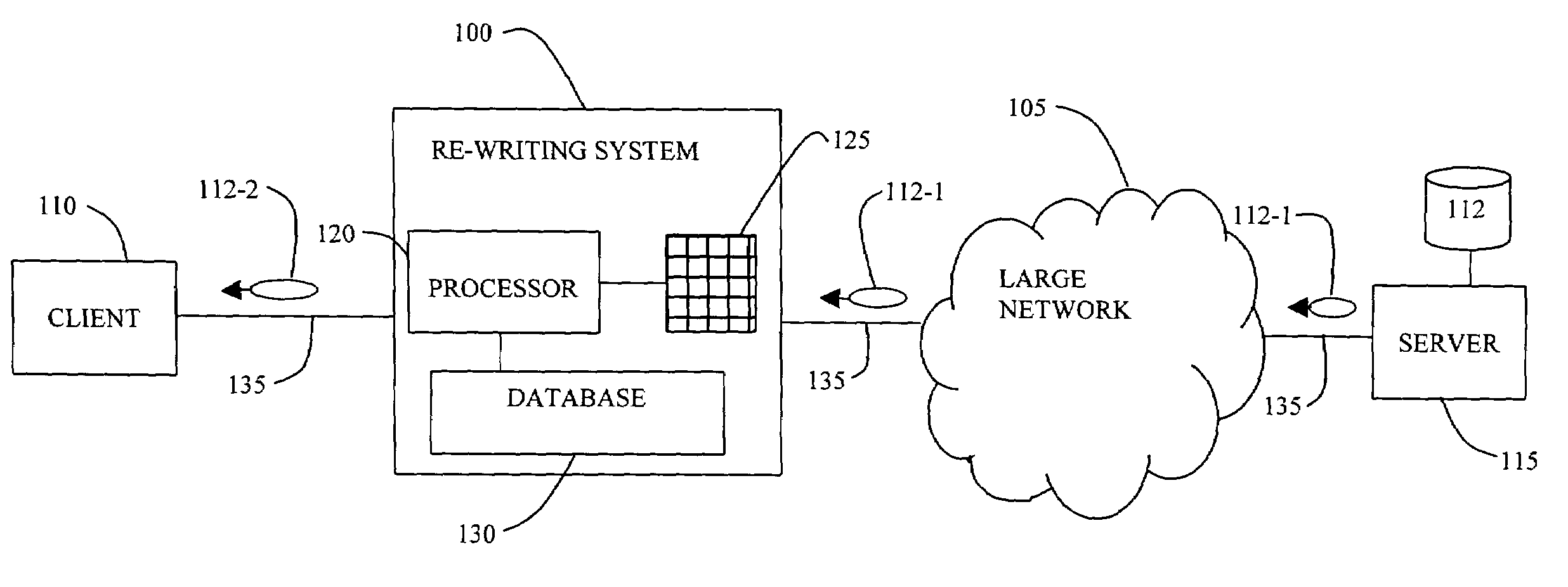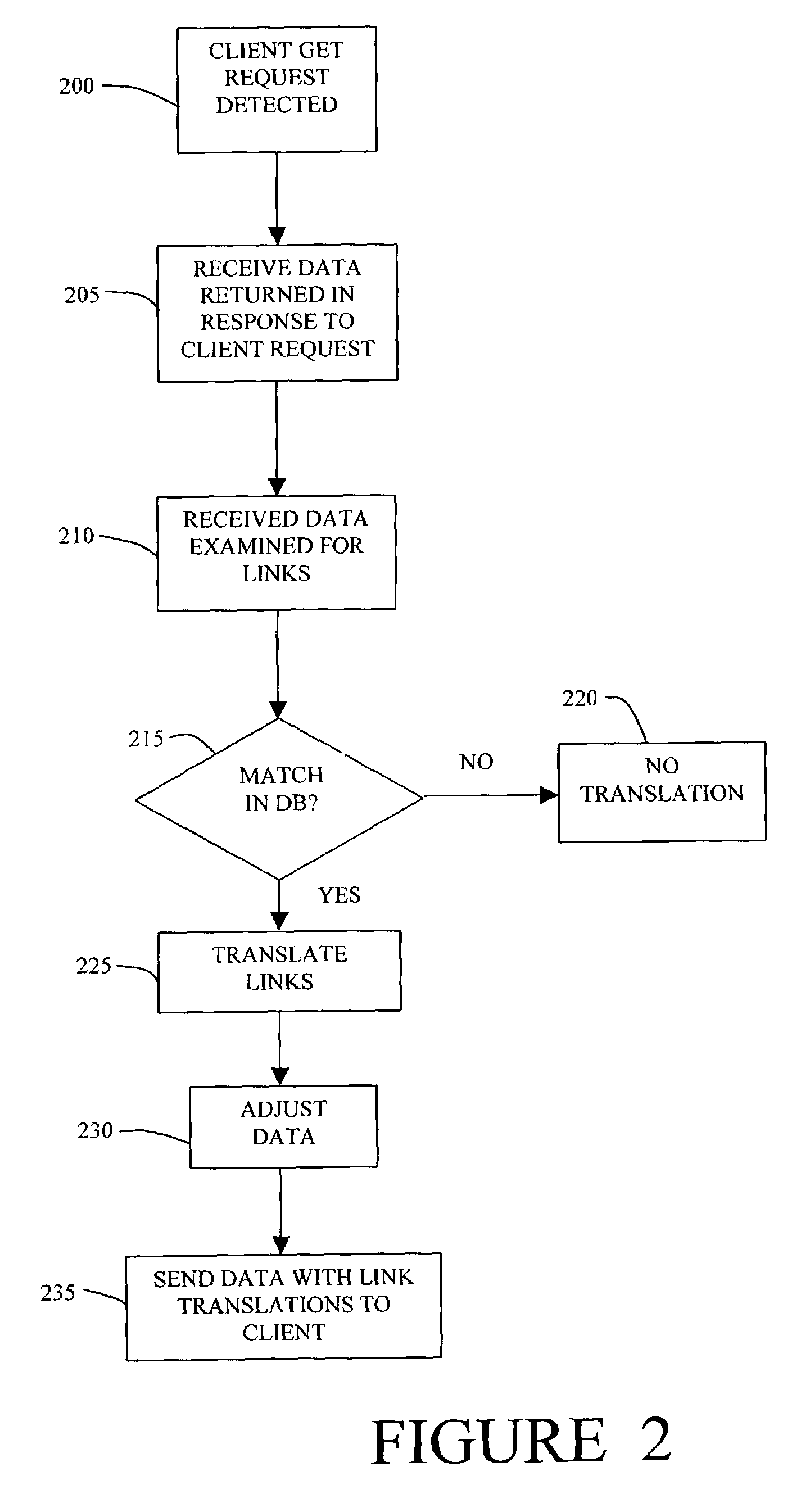System and method for generalized URL-rewriting
a generalized url and url technology, applied in the field of generalized url rewriting, can solve the problems of not supporting the current network technology for altering the url in data, blocking access to sites with objectionable content, blocking advertisements, etc., to speed up the overall page download speed, reduce the overhead of dns request/reply, and efficient content routing
- Summary
- Abstract
- Description
- Claims
- Application Information
AI Technical Summary
Benefits of technology
Problems solved by technology
Method used
Image
Examples
first embodiment
[0029]FIG. 1 is a block diagram of a re-writing system 100 according to principles of the invention operating in a large network 105 such as the Internet illustrating the invention. The re-writing system 100 is located in the data pathway 135 between a client 110 and a server 115 connected to the network 105. The re-writing system 100 has a processor 120, a memory 125 and a database 130. The database 130 stores original URLs and associated alternate URLs. In a first arrangement of the invention, the alternative URLs are URLs pointing to alternative locations where the same data can be found as the data pointed to by the original URL. In a second arrangement, the alternative URLs have replacement domain names meant to disguise the original URL domain names. In a third arrangement of the invention, the alternative URLs are URLs pointing to data meant to replace or to supplement the data pointed to initially in the original URL.
[0030]In operation, the client 110 makes a request for dat...
second embodiment
[0033]FIG. 3 illustrates the re-writing system 100 where the re-writing system 100 is configured for a content distribution network (CDN). The large network 105 connects the client 110 to the server 115 and to a content engine 300. The content engine 300 contains a copy of the data from the server 115. The network 105 also has a content router 305 to route requests in the CDN. The re-writing system 100 is implemented as part of the content router 305. In the present embodiment, the database 130 of the re-writing system 100 stores originating server URLs paired with URLs pointing to content engines.
[0034]In operation, the client 110 sends a GET request to the server 115 for example requesting a Web page. The content router 305 intercepts the GET request. When the content router 305 intercepts the client request, the re-writing system 100 compares the requested URL with those stored in its database 130. If it finds match, the re-writing system then directs the client request to the co...
third embodiment
[0036]FIG. 5 is a block diagram of a network including the re-writing system 100 in a third embodiment where the re-writing system 100 is configured to circumvent ad blockers and Web filters. The client 110 is connected to the server 115 by the network 105. The client 110 has a filter 500 that has the ability to block certain Web content. The re-writing system 100 is implemented in an ISP 505 through which the client 110 accesses the network 105. Also connected to the network 105 is an advertisement publisher 510.
[0037]There are currently available Web filters and proxies that remove Web content based on domain name. The filters are typically used to block Web sites with objectionable content or to block advertisements. The capability of guaranteeing that customers cannot filter particular URLs and IP addresses can be a business opportunity for ISPs. An ISP with a re-writing system 100 could enable an advertiser to launch a successful advertisement campaign with decreased interferen...
PUM
 Login to View More
Login to View More Abstract
Description
Claims
Application Information
 Login to View More
Login to View More - R&D
- Intellectual Property
- Life Sciences
- Materials
- Tech Scout
- Unparalleled Data Quality
- Higher Quality Content
- 60% Fewer Hallucinations
Browse by: Latest US Patents, China's latest patents, Technical Efficacy Thesaurus, Application Domain, Technology Topic, Popular Technical Reports.
© 2025 PatSnap. All rights reserved.Legal|Privacy policy|Modern Slavery Act Transparency Statement|Sitemap|About US| Contact US: help@patsnap.com



